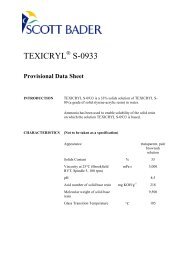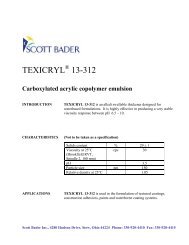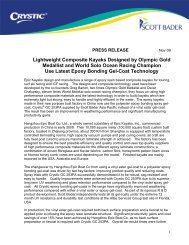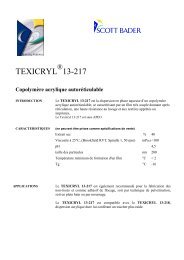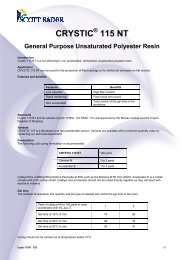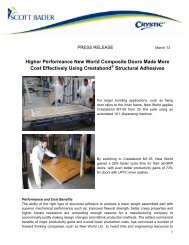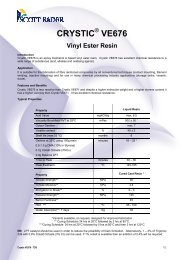Crystic Topcoat 408PA White - English - Scott Bader
Crystic Topcoat 408PA White - English - Scott Bader
Crystic Topcoat 408PA White - English - Scott Bader
Create successful ePaper yourself
Turn your PDF publications into a flip-book with our unique Google optimized e-Paper software.
CRYSTIC ® TOPCOAT <strong>408PA</strong> WHITE<br />
<strong>White</strong> Pigmented Orthophthalic Polyester<br />
Flowcoat<br />
Introduction<br />
<strong>Crystic</strong> <strong>Topcoat</strong> <strong>408PA</strong> <strong>White</strong> is a pre-accelerated topcoat with excellent scuff resistance, designed for use in general<br />
purpose GRP mouldings. It is based on a high quality orthophthalic unsaturated polyester resin. It is suitable for all<br />
general moulding requirements. It is pigmented using a highly UV resistant grade of titanium dioxide. It has been<br />
formulated for application using spray equipment, but may be applied by brush where a lower viscosity is preferred. A<br />
version designed specifically for use with a brush, <strong>Crystic</strong> <strong>Topcoat</strong> 407PA <strong>White</strong>, is available.<br />
Applications<br />
<strong>Crystic</strong> <strong>Topcoat</strong> <strong>408PA</strong> <strong>White</strong> is designed for application on the back of GRP mouldings, as a decorative, protective<br />
coating for the laminate. It will resist mild chemical attack from cleaning agents, etc, but it is not designed for use on the<br />
inner surfaces of vessels holding water. For such an application, <strong>Crystic</strong> <strong>Topcoat</strong> 506PA <strong>White</strong> is recommended.<br />
Formulation<br />
<strong>Crystic</strong> <strong>Topcoat</strong> <strong>408PA</strong> <strong>White</strong> should be allowed to attain workshop temperature (18ºC-20°C) before use. Stir well by<br />
hand, or with a low shear mixer to avoid aeration, and then allow to stand to regain thixotropy. <strong>Crystic</strong> <strong>Topcoat</strong> <strong>408PA</strong><br />
<strong>White</strong> requires only the addition of catalyst to start the curing reaction. The recommended catalyst is Andonox ® KP9,<br />
and this should be added at 1-3% into the <strong>Topcoat</strong>. In hot weather, the pot life can be so short even with 1% Andonox ®<br />
KP9 catalyst, it is difficult to avoid the material gelling in the pot. Do not use less than 1% Andonox ® KP9 catalyst. Rather<br />
use Norox ® MEKP-925H catalyst. The catalyst should be thoroughly incorporated into the <strong>Topcoat</strong>, with a low shear<br />
mechanical stirrer where possible.<br />
Pot Life<br />
The temperature, and the amount of Andonox ® KP9 catalyst or Norox ® MEKP-925H catalyst affect the geltime, and<br />
hence the pot life of <strong>Crystic</strong> <strong>Topcoat</strong> <strong>408PA</strong> <strong>White</strong>. The below table shows geltime in minutes of <strong>Crystic</strong> <strong>Topcoat</strong> <strong>408PA</strong><br />
at varying temperatures.<br />
= Combination not recommended.<br />
Catalyst Type Andonox ® KP9 Norox ® MEKP-925H<br />
Catalyst Addition<br />
Temperature<br />
1% 2% 3% 1% 2% 3%<br />
15ºC 17’ 14’<br />
Geltime In Minutes<br />
25ºC 14’ 11’ 32’ 13’<br />
35ºC 7’ 5’ 15’ 7’<br />
The topcoat, moulding and workshop should all be at or above, 15°C before curing is carried out. <strong>Scott</strong> <strong>Bader</strong> (Pty) Ltd.<br />
will not be liable for problems caused by use at lower temperatures than recommended.<br />
N.B. Peroxide catalysts are highly reactive and may decompose with explosive violence, or cause fires, if they come into<br />
contact with flammable materials, metals or accelerators. For this reason they must never be stored in metal containers<br />
or be mixed directly with accelerators.<br />
Application<br />
<strong>Crystic</strong> <strong>Topcoat</strong> <strong>408PA</strong> <strong>White</strong> is designed for application by spray gun to the back of GRP laminates in order to protect<br />
the fibres from water attack and to provide an attractive finish. Coverage and the evenness of finish is affected greatly by<br />
the evenness of the laminate. Measures taken to achieve a smooth finish, such as sanding or the use of surface tissue,<br />
will result in a smoother topcoated surface. It will also reduce the amount of <strong>Crystic</strong> <strong>Topcoat</strong> <strong>408PA</strong> <strong>White</strong> required to<br />
<strong>Crystic</strong> <strong>Topcoat</strong> <strong>408PA</strong> <strong>White</strong> - TDS 1/2
cover the surface. In normal use, the application of should be controlled to 0.4-0.5 mm wet film thickness. As a guide,<br />
approximately 500-700 g/m 2 of topcoat mixture will give the required thickness when evenly applied.<br />
Additives<br />
The addition of fillers to <strong>Crystic</strong> <strong>Topcoat</strong> <strong>408PA</strong> <strong>White</strong> can adversely affect the water and scuff resistance of the cured<br />
<strong>Topcoat</strong>. Should coloured <strong>Topcoat</strong> be required, <strong>Crystic</strong> <strong>Topcoat</strong> <strong>408PA</strong> can be supplied in a range of colours, or may be<br />
pigmented using <strong>Crystic</strong> Pigment Pastes.<br />
Physical Data - Uncured<br />
The following table gives typical properties of <strong>Crystic</strong> <strong>Topcoat</strong> <strong>408PA</strong> <strong>White</strong>.<br />
Property Unit Liquid <strong>Topcoat</strong><br />
Appearance<br />
Viscous <strong>White</strong> Liquid<br />
Viscosity at 25ºC, Brookfield RVT at 100 rpm Centipoise 2500<br />
Thixotropic index Ratio 2.8<br />
Geltime at 25ºC Using 2% Catalyst M Minutes 11<br />
Film Geltime at 500 Microns at 25ºC Using 2%<br />
Andonox ® KP9 Catalyst<br />
Minutes 16<br />
Stability In The Dark at 20ºC Months 3<br />
Storage<br />
<strong>Crystic</strong> <strong>Topcoat</strong> <strong>408PA</strong> <strong>White</strong> should be stored in the dark in suitable, closed containers. It is recommended that the<br />
storage temperature should be less than 20ºC where practical, but should not exceed 30ºC. Ideally, containers should<br />
be opened only immediately prior to use. Where they have to be stored outside, it is recommended that drums be kept in<br />
a horizontal position to avoid the possible ingress of water. Wherever possible, containers should be stored under cover.<br />
Packaging<br />
<strong>Crystic</strong> <strong>Topcoat</strong> <strong>408PA</strong> <strong>White</strong> is supplied in 25Kg and 225Kg containers.<br />
Health and Safety<br />
Please see the applicable Material Safety Data Sheets, depending on the curing system used.<br />
Technical Leaflet No. SBPTY054.3<br />
Version 2 : February 2013<br />
All information on this data sheet is based on laboratory testing and is not intended for design purposes. <strong>Scott</strong> <strong>Bader</strong> makes no representations or warranties of any<br />
kind concerning this data. Due to variance of storage, handling and application of these materials, <strong>Scott</strong> <strong>Bader</strong> cannot accept liability for results obtained. The<br />
manufacture of materials is the subject of granted patents and patent applications; freedom to operate patented processes is not implied by this publication.<br />
SCOTT BADER COMPANY LIMITED<br />
Wollaston, Wellingborough, Northamptonshire, NN29 7RL<br />
Telephone: +44 (0) 1933 663100<br />
Facsimile: +44 (0) 1933 666623<br />
www.scottbader.com<br />
<strong>Crystic</strong> <strong>Topcoat</strong> <strong>408PA</strong> <strong>White</strong> - TDS 2/2





